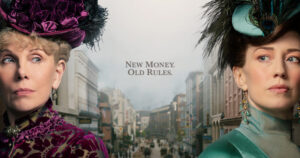I just caught up with the latest episode of The Gilded Age and I’m happy to report myself moderately satisfied. Episode Six: Heads Have Rolled for Less than This wasn’t the greatest piece of film in cinematographic history but it showed a marked improvement over episode five.
However, that is not the topic of today’s blog. Today I will discuss transitions. Not particularly exciting, I know, but bear with me.
Transitions: going from one scene to the next. I’ve commented before that the scenes in The Gilded Age don’t have a common thread. That we’re thrown from one to the next without a lifeline to guide us. I tried to explain this in a previous review but two transitions in this episode particular illustrate the point I tried to make then.
Bad Transitions at the Red Cross Meeting
The scene begins with Marion and Peggy walking down the street discussing various things and ends with their arrival at the front of the building in which the meeting will take place. They are greeted by Clara Barton who exits a coach, speaks with them briefly, and then heads inside.
The scene cuts and we are now at the Van Rhijn household although it took me until almost the scene finished to figure this out. The transition was quick and without explanation. I had no idea where I was or who was talking. It turned out to be the maid and Ada Brook. The maid paying back the loan taken to cover her gambling debts.
Then the next scene we are inside at the Red Cross meeting where Mrs. Russell is being discussed. The transition between the Red Cross scenes served only to confuse me.
Why place the maid scene in between the two others? It made no sense and forced my mind away from the goings on at the Red Cross, the topics being discussed by Marion and Peggy, the general flow of the story.
The transitions did not enhance either of the scenes and there seemed to be no connection. It was jarring, unnerving even, and certainly took me out of the flow.
Good Transitions at Lunchtime
The good transition begins in the servants’ quarters at the Van Rhijn household where young Jack is filling in for Bannister. He nervously prepares to serve the luncheon and is encouraged by Bridget as he heads off into the lion’s den to face the aunts.
As he opens the door the transition happens. The doors that open are those at the Russell household where the grand lunch is being served. It was perfect, seamless, and purposeful.
This illustrates that scene transitions don’t necessarily have to be about related events. It was the simple fact that doors opened to a luncheon, in different locations, that worked.
Film Editing
The film editor sorted through various scenes and chose to put these scenes next to one another. That’s a conscious action. It’s done presumably for a reason and yet I can find no good reason for the first instance and applaud heartily the second.
It’s frustrating to see the luncheon transitions because it means the film editor is actually paying attention. If the film editor observed such attention to detail in one case, why not in others?
Conclusion
Why, I ask, why? It’s clear someone does know how to create good transitions. The luncheon proves it. Why not do it more frequently? Why not structure the episode so that one scene flows into the next without jarring the audience?
I hope this small illustration gives you a better idea what I tried to convey in my other blog. Good transitions and proper scene structure can enhance a show greatly.
Tom Liberman
